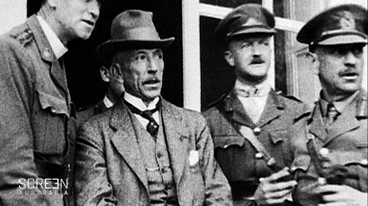Free for educational use
Monash and Billy Hughes
Year of production - tba
Duration - 4min 42sec
Tags - ANZAC, Australian History, defence, documentary, Gallipoli, heritage, historical representations, leadership, media influence, Monash, representations of war, World War 1, see all tags

How to Download the Video Clip
To download a free copy of this Video Clip choose from the options below. These require the free Quicktime Player.
![]() Premium MP4 monbill_pr.mp4 (34.7MB).
Premium MP4 monbill_pr.mp4 (34.7MB).
![]() Broadband MP4 monbill_bb.mp4 (16.4MB), suitable for iPods and computer downloads.
Broadband MP4 monbill_bb.mp4 (16.4MB), suitable for iPods and computer downloads.
Monash and Billy Hughes is an excerpt from the documentary Monash – The Forgotten Anzac, produced in 2008.
Monash – The Forgotten Anzac One of the most brilliant generals of World War I and an architect of Anzac Day, Sir John Monash helped create the Anzac legend by ensuring the courage of his men was enshrined in Australian history. Today he is all but forgotten. Monash – The Forgotten Anzac explores the character and achievements of an extraordinary figure in Australian history, the battles he fought both on and off the battlefield, and the prejudice he overcame to help win a war. Monash – The Forgotten Anzac is a Screen Australia Making History Production in association with 360 Degree Films. Produced with the assistance of Film Victoria. Developed and produced in association with the Australian Broadcasting Corporation.Special Thanks to the Australian War Memorial and the National Film and Sound Archive (of Australia).
Sir John Monash (1865-1931) commanded troops during some of the most famous battles World War 1. He gained a reputation as a great military planner and strategist, which led to battlefield victories in France and Belgium and a knighthood.
These successes, however, were preceded by the terrible defeat suffered by the Australian and New Zealand forces under British command at Gallipoli, Turkey, now commemorated on Anzac Day.
Monash was a most unlikely Digger hero. Of Prussian-Jewish extraction, cultured, fussy, an organized, methodical disciplinarian to the point of obsessive, he was a middle-aged, overweight citizen-soldier with no active war experience when hostilities broke out in 1914. Yet he was the leader Australian soldiers needed both during and after the war.
With the withdrawal from the Turkish peninsula, Monash and most of the Australian forces were sent to the western front in France. The reality of industrialised warfare became apparent; mile upon mile of trenches, barbed wire, mud and extraordinarily heavy artillery. Through many trials and errors, the Australian Divisions were starting to become the hardened, intelligent fighting force which would prove so effective by 1918, when Monash and the AIF (Australian Imperial Forces) played a crucial role in defeating Germany on the western front.
In 1916 the Australian Government, under Prime Minister William Morris (Billy) Hughes, called for conscription of Australian men to supply replacements for the casualties; voluntary recruiting did not seem to be producing sufficient numbers to supply the front line.
Hughes held a referendum in which the people of Australia had to indicate whether they supported or opposed conscription. The referendum caused great divisions in Australian society and within Hughes’ own governing Australian Labor Party.
The referendum was very narrowly defeated.
- Find out when Billy Hughes became Prime Minister of Australia.
- How long did he hold this position
- The clip opens with a dramatised conversation between Monash and Hughes. Listen carefully. What do each mans’ words mean? How do facial expressions and body language add to meanings? Monash says, “I will not voluntarily forgo this command”. What does he mean? What personal qualities does he demonstrate in this conversation? Do you think this is an accurate portrayal? Why or why not?
- An archival clip shows Hughes and soldiers. What do you think is happening and why do you think this? A dramatised scene follows featuring Hughes and Keith Murdoch (Australian journalist and newspaper publisher). How might it influence the meaning viewers attach to the preceding archival footage?
- Monash is allocated 2000 American soldiers. However, their General objects to them fighting under a foreign commander (Monash) and wants them withdrawn. In another dramatised scene Monash’s boss, General Rawlinson, delivers the news.
- Describe Monash’s response.
- What impression does this dramatisation create about Monash as a person and as a leader? How would you describe his relationship with Rawlinson? List words and phrases to describe Monash’s character.
- Investigate the Battle of Hamel.
- When and where did it occur? Why was it significant?
- Monash’s personal account of the Battle of Hamel is accompanied by archival footage. Watch carefully, listen to Monash’s account and to the music that forms part of the soundtrack. Why might this music have been selected? What does it convey and how does it relate to Monash’s words? What is the impact of combining this music with the archival footage and Monash’s words?
- List the technology of war you observe in the archival battle footage and the tactics and strategies Monash employs.
- What do you think was the key to the success of the Battle of Hamel? Monash describes it as the ‘perfection of teamwork’. Do you agree? Why or why not?


